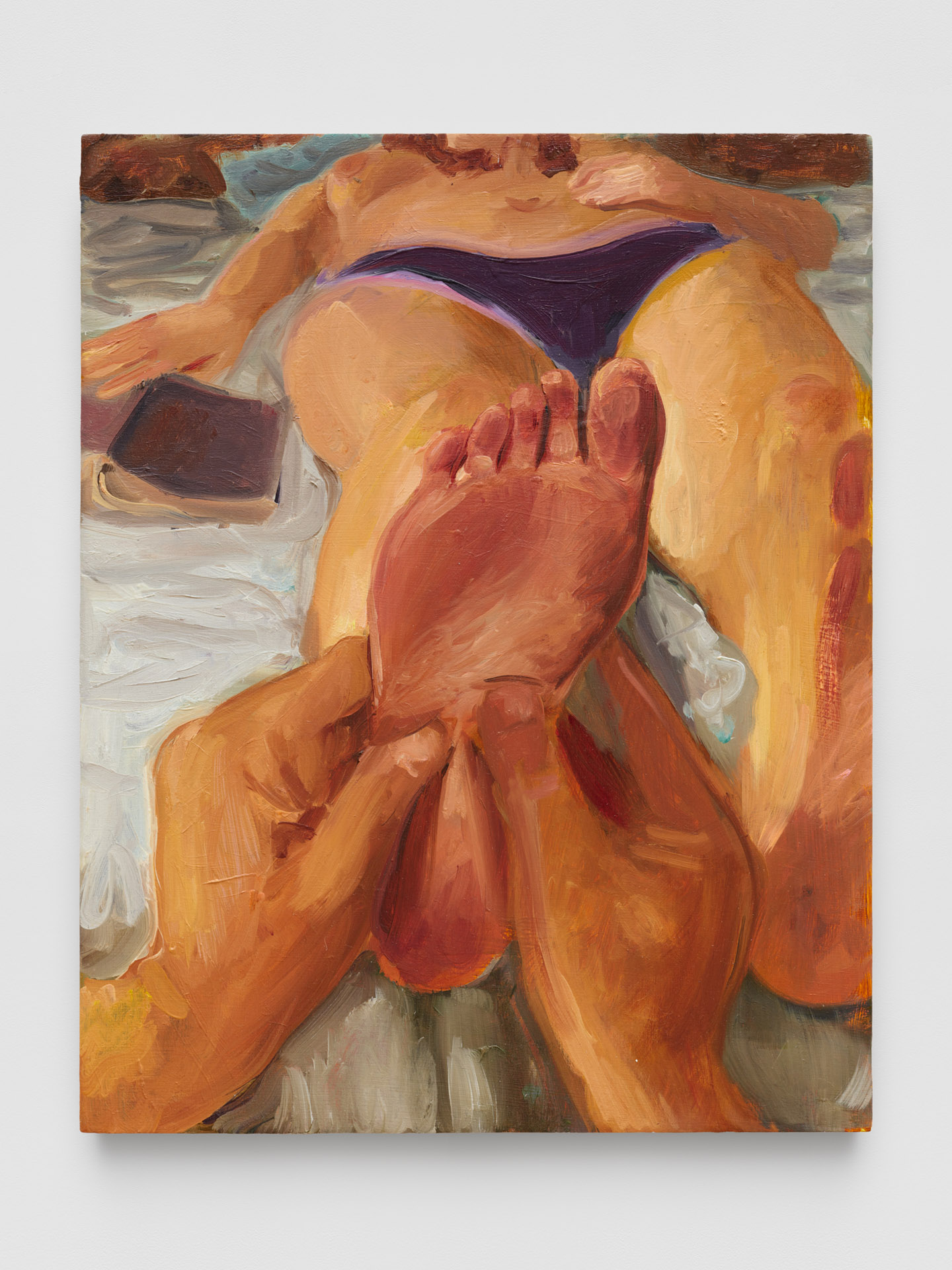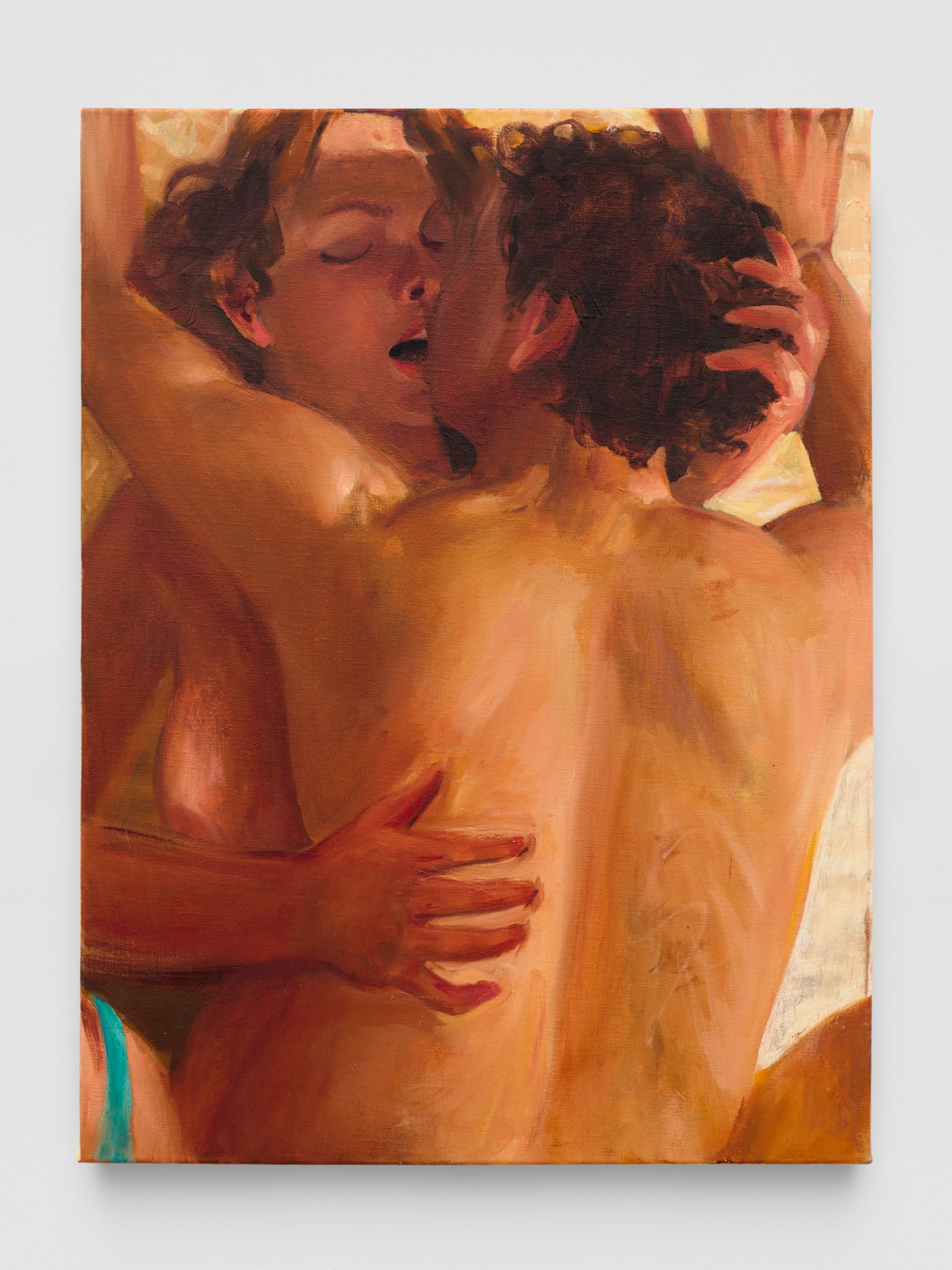LAST DAY TO SEE LARRY MADRIGAL’S EXHIBIT IN NYC!!!
Nicodim Gallery is tucked behind a temporary girder due to road work on Greene Street. It’s a little odd to open the door and walk right in on intimate scenes from Larry Madrigal’s marriage. Per the exhibition’s press release:
Over the course of creating Work / Life, the artist and his wife conceived their second child. He watched his wife’s body change while his pretty-much stayed the same. She is a mother, he is still Larry…
He’s out to make himself useful. Madrigal confessed somewhere — maybe on his instagram — that he wasn’t sure his massage below was doing any good, until his wife put her book down…

During his amore’s pregnancy he often felt like the odd man out. His painting here brings home how there’s no real place for him to view his wife’s sonogram in the doctor’s office…

Not that he’s the only one at the mercy of “basic melancholia” — to borrow the title of his painting of post-coital mood-swings…

The art-books on his shelves hint at some of Madrigal’s recent guides to dramas of domesticity. The Van Gogh reference reminds me how a stool painted by VG shows up the insufficiency of the “great,” the “august” subject. (Pace Adorno.) Larry’s workaday Work/Life, though, isn’t always removed from higher things. Try his “Supplications”…

You need to see that prayer live, though, for the punctum to come through. The sleeping matriarch’s nipple is worthy of Glenda Jackson’s in Women in Love. (I believe Ms. Jackson was in the early stages of pregnancy when that movie’s nude scenes were shot.)
There’s another painting in the new show that needs to be seen closeup. The feel of “Fleshly” starts with the mesh that shows through the paint on the canvas…

This time around, the artist’s heart is in his wife’s open mouth, which evokes the sensation of another aperture. Her fingers — leaving indents close to his spine and clasping the back of his head — point there too. “Fleshly” melds opening with tightening.
Larry M., though, doesn’t paint his wife’s most private caverns nor does he limn his own junk. He’s not out to bare all their secrets. But he’s probably also aware tactile values may be enhanced by not knowing. Think of that guy Genet shacked up with — and yearned for — who made him zip up his pants for months without letting him see what he was working with…”Unable to see it I invented the biggest loveliest prick in the world. I endowed it with qualities — heavy, strong, nervous, sober, with a tendency toward pride yet serene…Beneath my fingers. I felt, sculpted in oak, its full veins, its palpitations, its heat, its pinkness, and at times the racing pulsation of the sperm…-”
Genet’s gay love-life may be a deep far from the sexing of Larry M.’s hetero-normies. OTOH, there is no such thing as normal?
Not since the French Revolution anyway. Which is still news per that Nicodim press release providing context for Work / Life. Once upon a pre-revolutionary time…
communities were structured like a body. Like the cells within us, each person’s lot in life was set more or less in stone before they were born, and humans procreated to supply the community with more people to fulfill their roles when they perished. Then the traditional cells within the community refused to comply with their pre-assigned work, and the old-world system faltered and died. People moved to cities en masse. The transition from Gesellschaft to Gemeinschaft made it easier for people to improve their stations in life, but it also meant that each of our bodies were no longer necessary for the whole of society to function. Suddenly, your life, your work could be completely unnecessary. Without an assigned role, it is possible to have no role at all. We can fall through the cracks without anyone noticing.
I’m not sure it makes sense to invoke the French Revolution. When it comes to the crack-up in familial life Madrigal’s trying to paint around, I’m guessing the American earthquake happened in the Sixties and Seventies. OTOH, maybe modernity is a French invention.
I’m going to skip out on revolutionary times, though, and go Dutch. Madrigal gives me dispensation here, implicitly. Notice how he put Jan Steen on his shelves in “Basic Melancholia.” Dutch genre paintings are definitely somewhere in the back story of “Embrace” where desire bubbles up amidst a middle class mess in the kitchen.

“Embrace” brings to mind commentary by one of Steen et al.’s greatest fans. A term I don’t much like but it has its diminishing uses in this inst since I’m invoking a thinker, Hegel, who presented himself as a fount of objectivity. Forget his pretensions on that front. Yet he’s good on what Madrigal’s masters were up to — “a triumph of art over the transitory.” Hegel zeroed in on the essence of Dutch genre paintings…
Velvet, metallic lustre, light, horses, servants, old women, peasants blowing smoke from cutty pipes, the glitter of wine in a transparent glass, chaps in dirty jackets playing with old cards—these and hundreds of other things are brought before our eyes in these pictures, things that we scarcely bother about in our daily life, for even if we play cards, drink wine, and chat about this and that, we are still engrossed by quite different interests.
He goes on…
If we look at the Dutch masters… we will no longer suppose that they should have avoided such subjects and portrayed only Greek gods, myths, and fables, or the Madonna, the Crucifixion, martyrs, Popes, saints male or female. What is an ingredient in any work of art is one in painting too: the vision of what man is as man, what the human spirit and character is, what man and this man is.
I’ll take that as my cue to slip out with one of Madrigal’s self-portraits (which seems worthy of Hegel’s Dutch pastry — “naïve delight and artistic freedom…freshness and cheerfulness of imagination…assured boldness of execution”).

“Larry Madrigal: Work / Life” is on view at Nicodim Gallery, New York, 15 Greene Street, through August 12th.